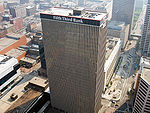Mercantile Library of Cincinnati
Buildings and structures in CincinnatiLibraries in OhioNRHPweekly errorsNational Register of Historic Places in Cincinnati

The Mercantile Library of Cincinnati is a membership library located in downtown Cincinnati, Ohio. The name of the Library refers not to the type of items in its collection but to the forty-five merchants and clerks who founded it on April 18, 1835 as the Young Men's Mercantile Library Association.
Excerpt from the Wikipedia article Mercantile Library of Cincinnati (License: CC BY-SA 3.0, Authors, Images).Mercantile Library of Cincinnati
Walnut Street, Cincinnati Central Business District
Geographical coordinates (GPS) Address Nearby Places Show on map
Geographical coordinates (GPS)
| Latitude | Longitude |
|---|---|
| N 39.101 ° | E -84.511111111111 ° |
Address
Traction Company Building
Walnut Street
45202 Cincinnati, Central Business District
Ohio, United States
Open on Google Maps







